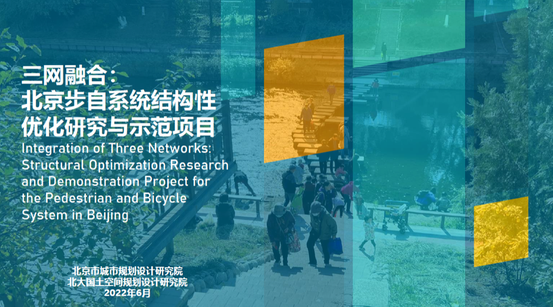Integrating the Design of Pedestrian Lanes, Greenways, and Waterfront Spaces in Beijing
On June 6, 2022, with the support of Energy Foundation China, the Beijing Municipal Institute of City Planning and Design and the Peking University Territorial Planning and Design Institute jointly held an expert workshop to review their research and demonstration project that aims to structurally optimize Beijing’s pedestrian and bicycle systems through integrating the three networks of pedestrian-bike lanes, greenways, and waterfront spaces. The experts agreed that this project would play a pioneer role in making the capital city more friendly to pedestrians and cyclists.


The integration of the three networks can enhance the efficiency of urban land use, improve the quality of public space, reduce duplicate investment and construction, and thus help Beijing optimize its non-motorized transport system toward lower carbon emissions, as well as improving collaboration among government agencies that oversee the different networks.
The project researchers first analyzed Beijing’s existing pedestrian-bike lanes, greenways, and waterfront spaces, and presented their findings in a problem list, a strategy toolbox, and a demonstration case. Despite the spatial closeness, the researchers found that integrating the three networks would face problems such as a lack of unified standards and coordination among water conservancy, urban management, and transportation regulators, non-continuous lanes and trails, and separated waterfronts. Based on the analysis, the project team proposed Beijing’s first “triple-network” integration strategy toolbox, which includes strategies and best practices for setting goals, improving each network, strengthening their connections, reserving eco-systems, and ensuring implementation. The project team also selected the Liangshui River waterfront trail in Beijing’s Fengtai District as a demonstration case. They proposed a conceptual integration plan for the improvement of the river’s walking and cycling environment and communicated with the district government several times, aiming to create an exemplary eco-friendly waterfront in southern Beijing.
The recently released Beijing’s local 14th Five-Year Plan for Transportation Development sets a mandatory green travel ratio target in central Beijing as 76.5 percent by 2025. The plan also requires to strengthen the integration of non-motorized transport systems with greenways and waterfront trails, and mentions building walking and biking lanes along Qing and Liangshui Rivers. Energy Foundation China supported this study to provide analysis and pilot findings as Beijing tries to become more friendly toward pedestrians and cyclists.
According to Huang Wei, Deputy Chief Planner of Tsinghua Tongheng Urban Planning and Design Institute and the lead expert of the project review workshop, this exploratory project reflected multiple perspectives with a cross-disciplinary approach. He said the experts looked forward to the continuous improvement of the recommended strategies and actions in the toolbox based on feedback from the public and regulators alike.
Wang Zhigao, Senior Director of Energy Foundation China’s Low Carbon Cities Program, said that integrating the design of pedestrian-bike lanes, greenways, and waterfront spaces would optimize urban spatial resources, improve the quality of life, and better serve the public, although cross-sectoral coordination could be very complex. In the future, Energy Foundation China would continue to support the integration in Beijing, and hopefully help establish relevant standards and coordination mechanisms, said him.



